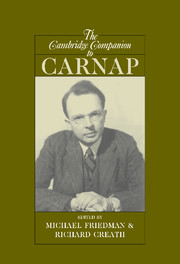Book contents
- Frontmatter
- Introduction: Carnap’s revolution in philosophy
- 1 Carnap’s intellectual development
- 2 Geometrical leitmotifs in Carnap’s early philosophy
- 3 Carnap and Frege
- 4 Carnap and Husserl
- 5 Carnap, Russell, and the external world
- 6 The Aufbau and the rejection of metaphysics
- 7 Carnap and the Vienna Circle: rational reconstructionism refined
- 8 Carnap and modern logic
- 9 Tolerance and logicism: logical syntax and the philosophy of mathematics
- 10 Carnap’s quest for analyticity: the Studies in Semantics
- 11 Carnap on the rational reconstruction of scientific theories
- 12 Carnap on probability and induction
- 13 Carnapian pragmatism
- 14 Quine’s challenge to Carnap
- Bibliography
- Index
6 - The Aufbau and the rejection of metaphysics
Published online by Cambridge University Press: 28 April 2008
- Frontmatter
- Introduction: Carnap’s revolution in philosophy
- 1 Carnap’s intellectual development
- 2 Geometrical leitmotifs in Carnap’s early philosophy
- 3 Carnap and Frege
- 4 Carnap and Husserl
- 5 Carnap, Russell, and the external world
- 6 The Aufbau and the rejection of metaphysics
- 7 Carnap and the Vienna Circle: rational reconstructionism refined
- 8 Carnap and modern logic
- 9 Tolerance and logicism: logical syntax and the philosophy of mathematics
- 10 Carnap’s quest for analyticity: the Studies in Semantics
- 11 Carnap on the rational reconstruction of scientific theories
- 12 Carnap on probability and induction
- 13 Carnapian pragmatism
- 14 Quine’s challenge to Carnap
- Bibliography
- Index
Summary
Der logische Aufbau der Welt (The logical construction of the world), first published in 1928, is a founding document of the analytic tradition in philosophy. During the heyday of the Vienna Circle, in the late 1920s and early 1930s, it served, along with Wittgenstein's Tractatus Logico-Philosophicus (1921), as one of the twin testaments of logical empiricism. In the immediately following period, however, marked by the rise of Nazism and the Second World War, many of the leading representatives of logical empiricism, including Carnap, emigrated to the English-speaking world, and the Aufbau went largely unread. Indeed, the second German edition appeared only in 1961, and it was not translated into English until 1967 – four years after the appearance of the Carnap volume in the Library of Living Philosophers. Meanwhile, a small number of prominent English-speaking philosophers did learn about Carnap and the Vienna Circle, and they articulated an initial understanding of Carnap’s Aufbau against which they then reacted both constructively and critically. A. J. Ayer's Language, Truth and Logic (1936) appealed centrally to the Aufbau in enunciating a notorious attack on all traditional metaphysics as meaningless, based on the principle of verifiability. W. V. Quine studied with Carnap in the early 1930s, and he later made the Aufbau a central object of criticism – rejecting the “dogma” of phenomenalistic reductionism – in his celebrated paper “Two Dogmas of Empiricism” (1951). Quine’s colleague Nelson Goodman, by contrast, strongly approved of phenomenalistic reductionism, and he attempted both to expound and to improve on the Aufbau in The Structure of Appearance (1951).
- Type
- Chapter
- Information
- The Cambridge Companion to Carnap , pp. 129 - 152Publisher: Cambridge University PressPrint publication year: 2007
- 10
- Cited by

